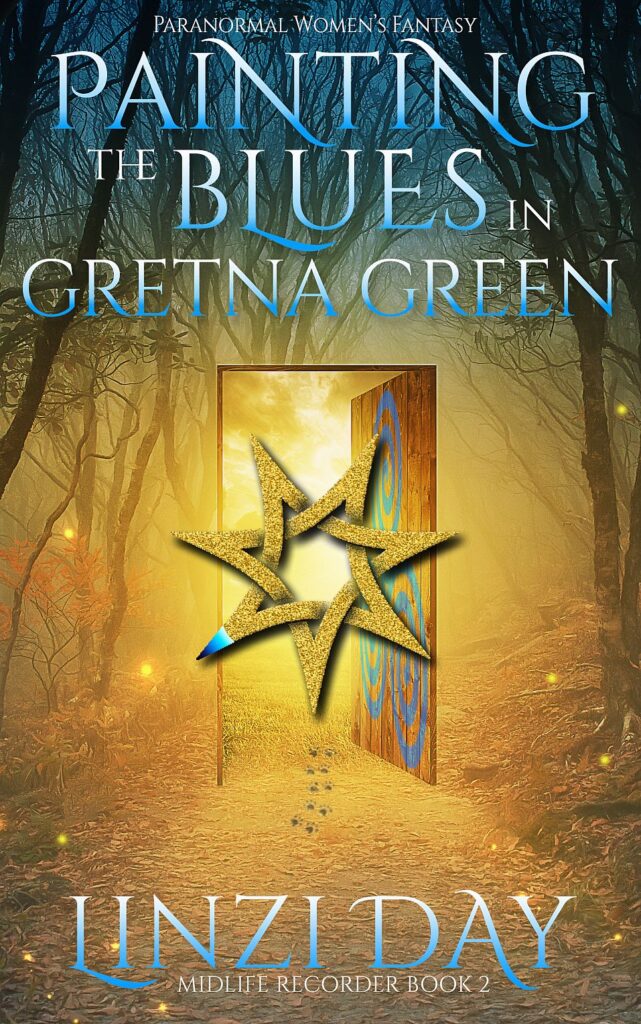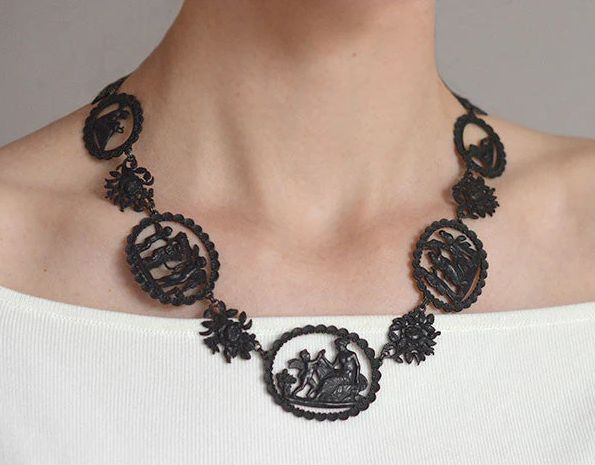
Continuing our series of Behind the Books features, we’re visiting the Smiths in Aberglas and looking at Berlin work. The iron jewellery that Niki bought for Aysha and Autumn.
Here’s a quick reminder
Page 336. Painting the Blues in Gretna Green.
Kindle 58%

“I saw some beautiful black necklaces in your shop just off the main square the other day. I think perhaps they were filigree. I bought several as gifts for my family.” I wasn’t going to explain Aysha and Autumn. Family was close enough for now.
“No, not filigree, not in that shop. Filigree is much too expensive for festival tourists. Yes, it is. They will have been Berlin work. Quite a different technique, oh, yes, quite different. The Germans did some clever things with iron once they’d relieved the rich of their gold for the war effort.”
I had no idea what he was talking about and said so.
“The Napoleonic wars in your history, not ours. Prussian royal family ran out of money. Talked rich women, well, rich women’s husbands probably back then, into handing over their gold jewellery for the war effort. Gave them cast iron jewellery back. Oh yes, they did.”
He glanced over to check I was listening and, when I nodded encouragingly, continued, “They engraved the original pieces. They say, ‘I gave gold for iron,’ very patriotic they thought themselves. Those original pieces are so rare now they’re worth almost more than gold. Time, it’s a bugger, isn’t it? Changes everything.”
So how much of this is true?
All of it.
It happened and the original pieces now sell for, as Hugh would say, “A very pretty price.”
Berlin-style Iron jewellery is still popular.
You’ll see from this set being sold by Tenenbaum Jewellers of Texas that the pieces command a fine price still.
Photo credit Tenenbaum Jewelers.

You can see an overview of the topic on the Wiki page HERE
But the site that inspired my own interest is this one. It discussed Berlin work in the context of mourning jewellery, which was its original purpose. In a time when women had as many black mourning dresses and coats as we now have black pants or leggings, the problem was jewellery.
Gold and gems were considered too flashy to wear while grieving a lost loved one. The origin of Berlin work was mourning jewellery. Something that could be worn for the year of mourning but wasn’t too expensive to put aside when women could resume wearing marginally lighter colours.
The change came in 1813 when the Prussians wanted a way to gather extra funds for the war effort against Napolean. Exactly as Hugh describes in Painting the Blues in Gretna Green the Berlin iron work jewellery was swapped for gold and gems.
Often inscribed with “Ich gab geld um Eisen” or “I gave gold for Iron” the pieces had to be attractive to encourage the exchange 😀
Strategy Audit website gives an interesting slant on the marketing behind the changes that Prussia had to create in the minds of their people.
Niki would be so proud!

Some of the pieces were quite chunky cast iron designs, often with a mythological slant on the motifs. Although the final work was flat, to lay smoothly against the skin. However, my informal research suggests that the filigree style, wire creations were more popular and are often worth more today. Perhaps that’s simply because the more delicate work didn’t survive the intervening two hundred years in such great shape.
Photo credit: A Brandt +Son
This style is more in tune with the pieces produced by the Smiths in the Midlife Recorder series.

And? Is there more?
I saved the most authentic until last.
Some of the original pieces are phenomenally delicate.
DON’T miss this selection which sold at auction recently. That page also covers some fascinating history and sheds light on how modern auctioneers set a value on the pieces.
What about the men?
They got off easy until the first world war. But by then the men were being targeted too in Germany. With the idea ‘borrowed’ from the Prussians and the Napoleonic wars. Although that isn’t discussed in the book. Their rings and watch chains were often swapped out for an iron version with a medallion commemorating their patriotism in place of the fob. You can read about that HERE
I hope a little more of the history behind the random, often throwaway comments in my books has given you an interesting and happy ten minutes?
What’s your opinion?
Do you like it? Which piece would you choose? Or isn’t it for you? Feel free to share your thoughts with us all in the comments.
Want more Behind the Books?
This is only a single part of the Behind the Books series. You can find the main index page here
This is fascinating and the jewelry is exquisite. The story behind it is extremely interesting. Thank you for your research and the time and patience to write this all up for our extra reading enjoyment. Many Blessings,
Melissa L Wolfenstein